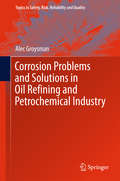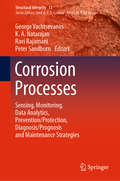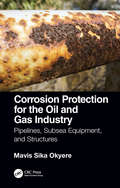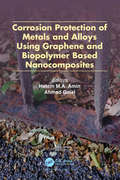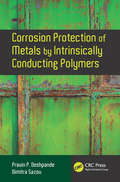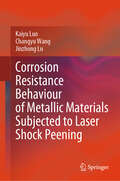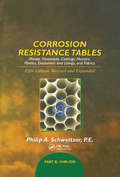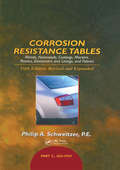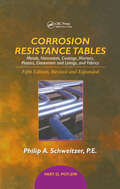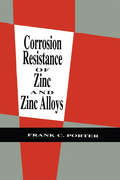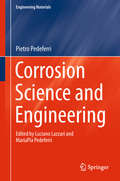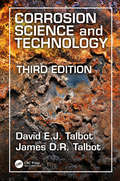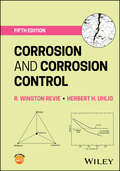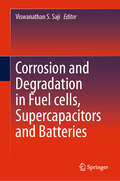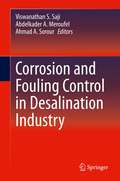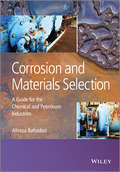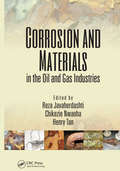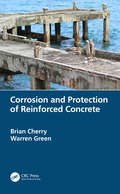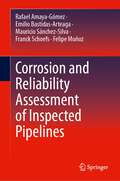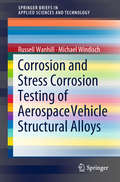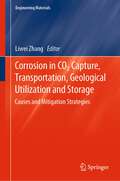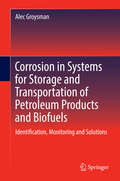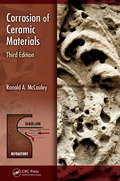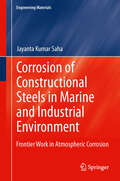- Table View
- List View
Corrosion Problems and Solutions in Oil Refining and Petrochemical Industry (Topics in Safety, Risk, Reliability and Quality #32)
by Alec GroysmanThis book addresses corrosion problems and their solutions at facilities in the oil refining and petrochemical industry, including cooling water and boiler feed water units. Further, it describes and analyzes corrosion control actions, corrosion monitoring, and corrosion management. Corrosion problems are a perennial issue in the oil refining and petrochemical industry, as they lead to a deterioration of the functional properties of metallic equipment and harm the environment - both of which need to be protected for the sake of current and future generations. Accordingly, this book examines and analyzes typical and atypical corrosion failure cases and their prevention at refineries and petrochemical facilities, including problems with: pipelines, tanks, furnaces, distillation columns, absorbers, heat exchangers, and pumps. In addition, it describes naphthenic acid corrosion, stress corrosion cracking, hydrogen damages, sulfidic corrosion, microbiologically induced corrosion, erosion-corrosion, and corrosion fatigue occurring at refinery units. At last, fouling, corrosion and cleaning are discussed in this book.
Corrosion Processes: Sensing, Monitoring, Data Analytics, Prevention/Protection, Diagnosis/Prognosis and Maintenance Strategies (Structural Integrity #13)
by Peter Sandborn George Vachtsevanos K. A. Natarajan Ravi RajamaniThis book discusses relevant topics in field of corrosion, from sensing strategies to modeling of control processes, corrosion prevention, detection of corrosion initiation, prediction of corrosion growth and evolution, to maintenance practices and return on investment.Written by leading international experts, it combines mathematical and scientific rigor with multiple case studies, examples, colorful images, case studies and numerous references exploring the essentials of corrosion in depth. It appeals to a wide readership, including corrosion engineers, managers, students and industrial and government staff, and can serve as a reference text for courses in materials, mechanical and aerospace engineering, as well as anyone working on corrosion processes.
Corrosion Protection for the Oil and Gas Industry: Pipelines, Subsea Equipment, and Structures
by Mavis OkyereCorrosion Protection for the Oil and Gas Industry: Pipelines, Subsea Equipment, and Structures summarizes the main causes of corrosion and requirements for materials protection, selection of corrosion-resistant materials and coating materials commonly used for corrosion protection, and the limitations to their use, application, and repair. <p><p>This book focuses on the protection of steels against corrosion in an aqueous environment, either immersed in seawater or buried. It also includes guidelines for the design of cathodic protection systems and reviews of cathodic protection methods, materials, installation, and monitoring. It is concerned primarily with the external and internal corrosion protection of onshore pipelines and subsea pipelines, but reference is also made to the protection of other equipment, subsea structures, risers, and shore approaches. Two case studies, design examples, and the author’s own experiences as a pipeline integrity engineer are featured in this book. Readers will develop a high quality and in-depth understanding of the corrosion protection methods available and apply them to solve corrosion engineering problems. <p><p>This book is aimed at students, practicing engineers, and scientists as an introduction to corrosion protection for the oil and gas industry, as well as to overcoming corrosion issues.
Corrosion Protection of Metals and Alloys Using Graphene and Biopolymer Based Nanocomposites
by Hatem M.A. Amin and Ahmed GalalWith contributions from experts from both academia and industry, this book provides up-to-date reviews and promising approaches for corrosion control of metals and alloys via sustainable biopolymers and carbon nanomaterials coatings, focusing on the wonder material “graphene” which is more solid than steel. This book delivers essential information for improving the environmental and economic viability of current coating technologies. It is also a valuable reference for those who are interested in corrosion science and corrosion protection including professionals from the industry as well as academia.
Corrosion Protection of Metals by Intrinsically Conducting Polymers
by Pravin P. Deshpande Dimitra SazouThe use of conducting polymers for the anticorrosion protection of metals has attracted great interest during the last 30 years. The design and development of conducting polymers-based coating systems with commercial viability is expected to be advanced by applying nanotechnology and has received substantial attention recently. This book begins wit
Corrosion Resistance Behaviour of Metallic Materials Subjected to Laser Shock Peening
by Jinzhong Lu Kaiyu Luo Changyu WangThis book introduces the fundamentals of laser shock peening (LSP) and its effects on the corrosion behaviours of metal alloy materials. It focuses on innovations in theory and methods related to LSP-induced surface nanocrystallization and corrosion resistance in steels, Mg alloy and titanium alloy. The main contents of the book include the characteristics of laser shock wave, LSP-induced surface integrity and the anti-corrosion mechanism. The research has accumulated a large amount of experimental data, which has proven the significant effectiveness of LSP in improving the corrosion performance of metal alloy materials. The related findings provide theoretical guidance and a data foundation for the application of LSP in fields such as aerospace and nuclear industry. This book could be useful for researchers working in the fields of LSP, corrosion behaviour, machine manufacturing and surface engineering, as well as those majoring in laser shock wave and materials science. The analysis in the book will help readers deeply understand the anti-corrosion mechanism induced by LSP and may inspire them to further develop this technology.
Corrosion Resistance Tables: Part B (Corrosion Technology)
by Philip A. Schweitzer, P.E.Devoted to the latest research on mechanisms of corrosion and advancements in corrosion resistance, the updated fifth edition accounts for recent advances and offers a convenient, single-source tabular guide to materials used in the construction of all system components- from vessels to pumps to gaskets and packing- for processes and applications. Part B of 4 parts: Metals, Nonmetals, Coatings, Mortars, Plastics, Elastomers and Linings, and Fabrics.
Corrosion Resistance Tables: Part C (Corrosion Technology)
by Philip A. Schweitzer, P.E.Devoted to the latest research on mechanisms of corrosion and advancements in corrosion resistance, the updated fifth edition accounts for recent advances and offers a convenient, single-source tabular guide to materials used in the construction of all system components- from vessels to pumps to gaskets and packing- for processes and applications. Part C of 4 parts, Metals, Nonmetals, Coatings, Mortars, Plastics, Elastomers and Linings, and Fabrics.
Corrosion Resistance Tables: Part D (Corrosion Technology)
by Philip A. Schweitzer, P.E.Devoted to the latest research on mechanisms of corrosion and advancements in corrosion resistance, the updated fifth edition accounts for recent advances and offers a convenient, single-source tabular guide to materials used in the construction of all system components- from vessels to pumps to gaskets and packing- for processes and applications. Part D of 4 parts.
Corrosion Resistance of Zinc and Zinc Alloys (Corrosion Technology)
by Frank C. PorterA cornerstone reference in the field, this work analyzes available information on the corrosion resistance of zinc and its alloys both as solid materials and as coatings on steel, detailing the corrosion resistance of zinc in atmospheric, aqueous, underground and chemical environments. Corrosion Resistance of Zinc and Zinc Alloys illustrates the nu
Corrosion Science and Engineering (Engineering Materials)
by Pietro PedeferriThis textbook discusses the latest advances in the corrosion of metals and related protection methods, and explores all corrosion-related aspects used in natural and industrial environments, including monitoring and testing. Throughout the textbook, the science and engineering of corrosion are merged to help readers perform correct corrosion assessments in both the design phase and plant management phase, and to define the optimal protection technique. In addition, the book addresses basic aspects of corrosion science, including the electrochemical mechanism, thermodynamic and kinetic aspects, the use of Pourbaix and Evans diagrams, and various forms of corrosion (from uniform to localised to stress corrosion phenomena); as well as the protection systems adopted to combat corrosion, including inhibitors, coatings and cathodic protection. Such basic knowledge is fundamental to understanding the “corrosion engineering” approach applied to the durability of metals immersed in water, buried in soil, exposed to the atmosphere, used in reinforced concrete, in the human body and in petrochemical plants, or at risk of high-temperature corrosion. A final chapter is dedicated to the use of statistics in corrosion. All chapters include exercises and practical examples to help students understand, predict, evaluate and mitigate corrosion problems. As such, the book offers the ideal learning resource for all students of corrosion courses in chemical, mechanical, energy and materials engineering at the graduate and advanced undergraduate level, as well as a valuable reference guide for engineers whose work involves real-world applications.
Corrosion Science and Technology
by David E.J. Talbot James D.R. TalbotTwenty years after its first publication, Corrosion Science and Technology continues to be a relevant practical guide for students and professionals interested in material science. This Third Edition thoroughly covers the basic principles of corrosion science in the same reader-friendly manner that made the previous edition invaluable, and enlarges the scope of the content with expanded chapters on processes for various metals and new technologies for limiting costs and metal degradation in a variety of commercial enterprises not explored in previous editions. This book also presents expertly developed methods of corrosion testing and prediction.
Corrosion and Corrosion Control
by R. Winston Revie Herbert H. UhligThe newest edition of the gold standard in corrosion reference resources In the newly revised fifth edition of Corrosion and Corrosion Control, distinguished scientist and program manager R. Winston Revie delivers a uniquely up-to-date resource reflecting the current knowledge of corrosion science and engineering. This book offers updated explanations of the essential aspects of corrosion science and engineering that underpin the tools and technologies used for managing and controlling corrosion. “Relying heavily on a quantitative approach – along with basic equations that are explained and derived, as well as illustrative problems with solutions – the basic thermodynamic and electrochemical principles that drive corrosion are discussed.” The book also includes practical corrosion control measures, like cathodic protection, coatings, inhibitors, and the use of plastics as a substitute for metals. Readers will also find: A thorough introduction to new materials, including multi-principal element alloys, and calculations of corrosion rates of alloysComprehensive explorations of corrosion-resistant materialsPractical discussions of texture as related to stress-corrosion crackingComplete treatments of materials reliability and risk in a variety of industries, including biomedical, energy, and transportation Perfect for advanced undergraduate and graduate students studying corrosion in engineering, materials science, and chemistry programs, Corrosion and Corrosion Control will also benefit engineers, scientists, and technologists, as well as lawyers engaged in litigation involving materials exposed to the environment.
Corrosion and Degradation in Fuel Cells, Supercapacitors and Batteries
by Viswanathan S. SajiThis book discusses research and development on various degradation types and their mitigation approaches in electrochemical energy storage and conversion (EESC) devices, such as fuel cells, batteries, and supercapacitors, essential to realizing carbon neutrality and a sustainable energy economy. Corrosion and degradation of the components remains a major threat to EESC devices' long-term durability, and at present there is an insufficient number of book-length treatments of this topic. This volume brings together the most up-to-date findings from the research literature.
Corrosion and Fouling Control in Desalination Industry
by Viswanathan S. Saji Abdelkader A. Meroufel Ahmad A. SorourThis book addresses two critical problems that plague materials that make up components in both desalination and cooling water systems: corrosion, and fouling. The book addresses various types and components of industrial desalination technologies with solutions for controlling corrosion, scaling and biofouling. Issues unique to desalination systems, vital for the production of clean water, are considered as well. Green technologies are discussed throughout, along with environmental and economic considerations. The book presents solutions to the problems encountered by internal and external parts of these systems and will aid professionals that design, operate, and maintain them. It will be valuable to professionals in the materials, corrosion, electrochemical and wastewater industries, as well as chemical engineers.Addresses the corrosion issues facing the conventional and modern water desalination systems;Discusses the causes and remediation of problems caused by corrosion, scaling, and biofouling in water treatment;Offers green solutions, thereby minimizing environmental impact while increasing control and productivity of water systems;Suitable for professionals working with water desalination plants, materials scientists and corrosion engineers.
Corrosion and Materials Selection
by Alireza BahadoriThe petroleum and chemical industries contain a wide variety of corrosive environments, many of which are unique to these industries. Oil and gas production operations consume a tremendous amount of iron and steel pipe, tubing, pumps, valves, and sucker rods. Metallic corrosion is costly. However, the cost of corrosion is not just financial. Beyond the huge direct outlay of funds to repair or replace corroded structures are the indirect costs - natural resources, potential hazards, and lost opportunity. Wasting natural resources is a direct contradiction to the growing need for sustainable development. By selecting the correct material and applying proper corrosion protection methods, these costs can be reduced, or even eliminated. This book provides a minimum design requirement for consideration when designing systems in order to prevent or control corrosion damage safely and economically, and addresses: * Corrosion problems in petroleum and chemical industries * Requirements for corrosion control * Chemical control of corrosive environments * Corrosion inhibitors in refineries and petrochemical plants * Materials selection and service life of materials * Surface preparation, protection and maintainability * Corrosion monitoring - plant inspection techniques and laboratory corrosion testing techniques Intended for engineers and industry personnel working in the petroleum and chemical industries, this book is also a valuable resource for research and development teams, safety engineers, corrosion specialists and researchers in chemical engineering, engineering and materials science.
Corrosion and Materials in the Oil and Gas Industries
by Chikezie Nwaoha Reza Javaherdashti Henry TanThe advancement of methods and technologies in the oil and gas industries calls for new insight into the corrosion problems these industries face daily. With the application of more precise instruments and laboratory techniques as well as the development of new scientific paradigms, corrosion professionals are also witnessing a new era in the way d
Corrosion and Protection of Marine Engineering Materials: Applications of Conducting Polymers and Their Composites
by Yanhua LeiThis book provides a basic introduction to the application of conductive polymers in corrosion protection, especially for marine environment corrosion protection research. Conventional anticorrosive coatings, which are based on heavy metals such as chromium, zinc, and copper, are toxic to the environment. There has been a need to find suitable replacement coatings that are environmentally friendly as well as effective in inhibiting the corrosion of steel. Conductive polymers have garnered much attention in recent years due to their environmentally benign nature and high effectiveness in protecting against corrosion. This book introduces the history of these conductive polymers. The applications of conducting polymers, polymer composites, and nanocomposites for corrosion protection of different industrial metal substrates are explored based on reported experimental data, and their mechanism of inhibition is explained. This book also includes overviews of some recent works on marine antifouling, marine heavy-protective coatings, and waterborne paints by conducting polymer and inorganic composites. Conducting polymers and their family of stimuli-actuated polymers exhibit excellent application prospects in the fields of anticorrosion, antibacterial, antibiofouling, and waterborne-based coatings. This book will be of great interest to students, scholars, and professionals alike in the field of corrosion engineering and material science.
Corrosion and Protection of Reinforced Concrete
by Warren Green Brian CherryReinforced concrete is the most widely used construction material in the world, and extended performance is rightly expected. Many structures are in aggressive environments, of critical importance and may be irreplaceable, so repair and protection are vital. This book surveys deterioration of concrete, particularly corrosion of the steel reinforcement, and the various chemical, biological, physical and mechanical causes of deterioration. It outlines condition survey and diagnosis techniques by on-site and laboratory measurements. It sets out mechanical methods of protection and repair, such as patching, inhibitors, coatings, penetrants and structural strengthening as well as cathodic protection and other electrochemical methods. This book also gives guidance on preventative measures including concrete technology and construction considerations, coatings and penetrants, alternate reinforcement, permanent corrosion monitoring and durability planning aspects. Asset managers, port engineers, bridge maintenance managers, building managers, heritage structure engineers, plant engineers, consulting engineers, architects, specialist contractors and construction material suppliers who have the task of resolving problems of corrosion of steel reinforced concrete elements will find this book an extremely useful resource. It will also be a valuable reference for students at postgraduate level. Authors The late Professor Brian Cherry of Monash University, Melbourne, Australia was one of the world’s leading corrosion science and engineering educators and researchers. Warren Green of Vinsi Partners, Sydney, Australia is a corrosion engineer and materials scientist. He is also an Adjunct Associate Professor.
Corrosion and Reliability Assessment of Inspected Pipelines
by Franck Schoefs Mauricio Sánchez-Silva Felipe Muñoz Rafael Amaya-Gómez Emilio Bastidas-ArteagaThis book provides the most up-to-date, advanced methods and tools for risk assessment of onshore pipelines. These methods and tools are based primarily on information collected from ILI measurements and additional information about the soil surrounding the pipeline. The book provides a better understanding how the defects grow and interact (repulsion or attraction) and their spatial variability. In addition, the authors contemplate new defects that evolve between inspections and how they could affect the pipeline's reliability. A real-world case is presented to reinforce the concepts presented in the book. The book is structured into three parts: i) an introduction to onshore pipelines and the problem of corrosion, ii) a framework that deals with uncertainty for integrity programs for corroded pipelines, and iii) the applications of the methods presented in the book. The book is ideal for researchers and field engineers in oil and gas transportation and graduate and undergraduate engineering students interested in pipeline reliability assessments, spatial variability, and risk-based inspections.
Corrosion and Stress Corrosion Testing of Aerospace Vehicle Structural Alloys (SpringerBriefs in Applied Sciences and Technology)
by Russell Wanhill Michael WindischThis SpringerBrief discusses the determination and classification of the ambient temperature corrosion and stress corrosion properties of aerospace structural alloys, with emphasis on (1) aluminium alloys, modern (3rd generation) aluminium‒lithium alloys, stainless steels and titanium alloys and (2) some of the issues involved. Standard /reference data on environmental properties, including corrosion and stress corrosion, are mandatory for the qualification and certification of materials for aerospace vehicles, and also for the design of actual structures and components. Recommendations for further testing and evaluation are given at appropriate points in the text. The book concludes with a summary of the main topics.
Corrosion in CO2 Capture, Transportation, Geological Utilization and Storage: Causes and Mitigation Strategies (Engineering Materials)
by Liwei ZhangThis book systematically discusses the operational stages with high risk of CO2-induced corrosion in CCUS projects, and related measures for corrosion control. CO2 capture, utilization, and storage (CCUS) is a key technology to mitigate climate change and substantially reduce greenhouse gas emissions from fossil fuels. CCUS deals with high concentration CO2, which is very corrosive in a humid environment. Therefore, it is very important to characterize, monitor, and mitigate CO2-induced corrosion in all processes of the CCUS operation chain. Some corrosion control techniques included in this book (e.g., CO2-resisting wellbore cement additives) are beneficial for corrosion control research and engineering practices. This book belongs to the field of corrosion science and engineering, and the expected readership is researchers and engineers working on CCUS.
Corrosion in Systems for Storage and Transportation of Petroleum Products and Biofuels: Identification, Monitoring and Solutions
by Alec GroysmanThis book treats corrosion as it occurs and affects processes in real-world situations, and thus points the way to practical solutions. Topics described include the conditions in which petroleum products are corrosive to metals; corrosion mechanisms of petroleum products; which parts of storage tanks containing crude oils and petroleum products undergo corrosion; dependence of corrosion in tanks on type of petroleum products; aggressiveness of petroleum products to polymeric material; how microorganisms take part in corrosion of tanks and pipes containing petroleum products; which corrosion monitoring methods are used in systems for storage and transportation of petroleum products; what corrosion control measures should be chosen; how to choose coatings for inner and outer surfaces of tanks containing petroleum products; and how different additives (oxygenates, aromatic solvents) to petroleum products and biofuels influence metallic and polymeric materials. The book is of interest to corrosion engineers, materials engineers, oil and gas engineers, petroleum engineers, chemists, chemical engineers, mechanical engineers, failure analysts, scientists, and students, designers of tanks, pipelines and other systems for storage and transportation fuels, technicians. The book is of interest to corrosion engineers, materials engineers, oil and gas engineers, petroleum engineers, chemists, chemical engineers, mechanical engineers, failure analysts, scientists, and students, designers of tanks, pipelines and other systems for storage and transportation fuels, technicians. The book is of interest to corrosion engineers, materials engineers, oil and gas engineers, petroleum engineers, chemists, chemical engineers, mechanical engineers, failure analysts, scientists, and students, designers of tanks, pipelines and other systems for storage and transportation fuels, technicians.
Corrosion of Ceramic Materials (Corrosion Technology)
by Ronald A. McCauleyReflecting the many changes in the field since the publication of the second edition, Corrosion of Ceramic Materials, Third Edition incorporates more information on bioceramics, including nanomaterials, as well as the weathering of construction materials. Adhering to the original plan of classification by chemistry, this edition reorganizes the top
Corrosion of Constructional Steels in Marine and Industrial Environment: Frontier Work in Atmospheric Corrosion (Engineering Materials)
by Jayanta Kumar SahaThe book entails investigative methods for better understanding of the degradation process and uses of high performance paints formulation and also compares them on mild steel (MS) and weathering steel (WS) through various AC/DC electrochemical test methods and surface characterization through electron microscopy, XRD and Raman spectroscopy. This book also deals with the corrosion studies undertaken considering three phases (solid, liquid and gas) with latest techniques and the emphasis has also been given on degradation of materials due to atmospheric corrosion as this is of immense interest to present engineers and researchers. MS has got versatile application as structural steel for construction of buildings, bridges, flyovers, pipelines etc. But this is very much prone to corrosion in industrial and marine environments in presence of harmful pollutants and other industrial effluents in addition to normal humid atmosphere. These corrosion problems are much severe in a tropical country like India with vast coastline. MS corrodes relatively faster and thus leads to colossal loss in every year and to reduce this loss some kind of protection in the form of paints and coatings is always used. Painting is an effective means but quite costly amounting 10-15% of the initial construction cost of superstructures besides cost of repainting at regular interval.
